One of the many new year's resolutions that I have managed to a keep was to walk every street within walking distance of the office at lunchtime. I had made a map of the the area surrounding my office, a square two kilometres on each side. It took me a while, but last month I coloured in all but two streets.
I had a few difficulties. One was keeping track of where I had been, the maps I had printed weren't detailed enough, but zooming in made it tricky to stick to the map boundaries. Marking the locations that I had been to was also a little tricky.
The square boundary meant I was missing locations that I could feasibly get to within my lunch hour.
What I needed was a circular overlay on google maps and a way of marking the streets I have travelled down so that I can print at any scale without losing track of the boundary. With any luck, if I have figured out the google maps API there will be a map below that does exactly that.
I'm going to start all over again and this time I'll take my time over it and take more photographs. I have also expanded my range to a one mile radius. The red square is the area where I have walked every street so far. So you can see there is still a lot more to do in the expanded area.
Edit:You might have noticed if you are visiting this page that there is a hide blog link below the map. This will make the map display at 800x800 for printing.
NB: The map may stop working on occasion as I am making updates
Tuesday, 29 April 2008
Monday, 28 April 2008
Solar Powered Beauty Dish
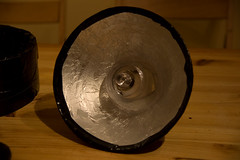 Ok, its not really solar powered, but I have found an inexpensive little gadget that can be pressed into service if you are building a DIY beauty dish. Woolworths sell a cheap solar powered garden light kit with eight lights. The lights have a platic dome with a mirrored hemisphere inside that is designed to throw light from the centre out sideways.
Ok, its not really solar powered, but I have found an inexpensive little gadget that can be pressed into service if you are building a DIY beauty dish. Woolworths sell a cheap solar powered garden light kit with eight lights. The lights have a platic dome with a mirrored hemisphere inside that is designed to throw light from the centre out sideways.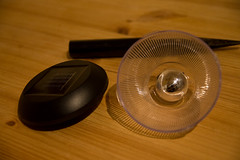 This can be placed in the centre of your DIY beauty dish to throw some of the light from your flash out to the sides of the dish. I used it on the 24cm gridspot I made earlier and it does help make the light more even eliminating the hotspot. If you are building a beauty dish, this could be the component you are looking for.
This can be placed in the centre of your DIY beauty dish to throw some of the light from your flash out to the sides of the dish. I used it on the 24cm gridspot I made earlier and it does help make the light more even eliminating the hotspot. If you are building a beauty dish, this could be the component you are looking for.What do you do with the leftover bits? The seven remaining lights can be used to light your garden at night, and the one you pulled apart can be used as a solar powered battery charger for AA Ni-CD batteries.
Monday, 14 April 2008
Matt and Alison's Wedding
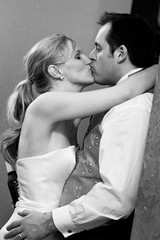 Alison and Matt got married last Saturday and I was given permission to take some pictures of them, as long as I didn't upset the official photographer. Thats them in the picture. I was under orders from my current wife not to take all my gear with me. So I travelled light without so much as a flashgun, just a handful of lenses. At the end of the evening I found myself in a very dark venue, with nothing but on-camera flash. I decided to put the camera on ISO6400 and went looking for pictures.
Alison and Matt got married last Saturday and I was given permission to take some pictures of them, as long as I didn't upset the official photographer. Thats them in the picture. I was under orders from my current wife not to take all my gear with me. So I travelled light without so much as a flashgun, just a handful of lenses. At the end of the evening I found myself in a very dark venue, with nothing but on-camera flash. I decided to put the camera on ISO6400 and went looking for pictures.
Had I used the on-camera flash for this image, several things might have happend.
1. They would have realised that someone as taking photos, and this wonderful moment might not have happened.
2. The flash recycling time might have stopped me for getting this precise moment, which was part of a quickfire sequence. The kiss only lasted a very short time.
3. I would have lost all of that lovely soft shadow on Alison's skin and more than likely lost all the detail in the dress.
4. I would have got a load of ugly shadows on the background.
5. You can't really see it on the uploaded image, but the grain is luscious. It really works for me.
This shot was taken in the brightest part of the venue and still required an exposure of ISO6400 to get a good exposure at F2.8 at 1/60s. The latest generation of cameras is really worth the expense of the upgrade if you need to take pictures in conditions like these.
For the dance floor I was forced to use the on-camera flash because it was simply too dark and the people too fast moving to get a shot without flash. But perhaps thats a subject for another article.
Tuesday, 8 April 2008
Specular Reflections
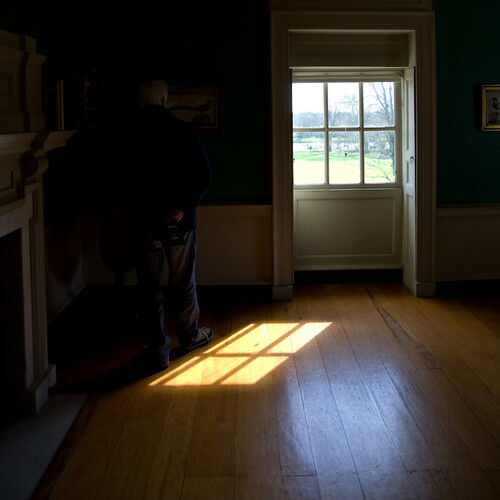
I thought this image is quite interesting and illustrates a useful property of light that can be used to good effect in photographs. You see in the above image, that the light from the window is directly illuminating the floor, creating a sharp image of the window. You will also see that in addition to this image of the window, There is another fainter image of the window on the floor to the right.
The second image is what is called a specular reflection. The window is reflected in the floor because the floor s glossy, but because the surface of the floor is quite bumpy, the light is reflected off in lots of different directions and the reflection is rendered rather fuzzy looking.
You can take advantage of this specular reflection to get two light sources out of one. You can illuminate your subject with direct light from the window and through careful choice of camera angles place the specular reflection in the image.
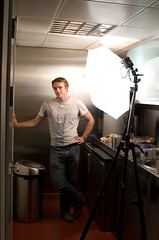 Using a fixed light source like a window can be a little inconvenient but if you have a strobe and a white shoot through umbrella you can do this anywhere where you have a reflective surface to bounce the specular reflection off. The smoother the surface, the more well defined the reflection.
Using a fixed light source like a window can be a little inconvenient but if you have a strobe and a white shoot through umbrella you can do this anywhere where you have a reflective surface to bounce the specular reflection off. The smoother the surface, the more well defined the reflection.
Here on strobist.com David Hobby put together a great tutorial on using specular highlights as a background element in portraits. This technique looks like magic until you figure out what is going on. Its something you can use with strobe lights, but also if you look for opportunities its something you might be able to use even with ambient light.
Subscribe to:
Comments (Atom)


